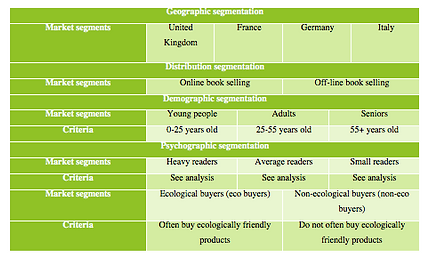

Segmentation
Entering the European market, we believe BetterWorldBooks should focus on specific market segments. The choice of the target market is largely based upon the analysis of the different segments detailed in the second part of our analysis. Besides, the particularities of the company, BetterWorldBooks, will also be taken into account in the definition of this target market.
What is segmentation?
The concept of market segmentation is very broad. According to Jerry W. Thomas (2007), “the purpose of market segmentation is the concentration of marketing energy and force on the subdivision (or the market segment) to gain a competitive advantage within the segment”.
There are different kind of consumers’ segmentation. Referring to Jerry W. Thomas (2007), there are seven main kind of market segmentation (geographic segmentation, distribution segmentation, media segmentation, price segmentation, psychographic or lifestyle segmentation, demographic segmentation and time segmentation).

Market segmentation

The first variable that will be taken into account is the geographical variable. Therefore, the strategy should vary according to a geographical segmentation that will consist in four market segments, i.e. United Kingdom, Germany, France and Italy.
Secondly, the distribution segmentation is very important regarding our market. Based on our previous analysis, two main distribution channels can be distinguished and should therefore be segmented. Given the fact that BetterWorldBooks is (almost) only active online, it is clear that this segmentation is more than relevant.
Then, the demographic segmentation should help us understand the particularities of each consumers’ group based on age.
Finally, it is relevant to understand the psychographic particularities of each segment in order to be able to address each group with a specific approach. Therefore, we will subdivide the demographic segment into other segments depending on the consumers’ reading habits.
The decision not to take into account the gender is based upon the fact that the differences in reading habits between men and women are not important enough to justify any segmentation. In addition, the social category will not be taken into account given the specificity of BetterWorldBooks and the fact that it sells new and second-hand books, which would distort the conclusion we may draw.
Measuring the segments
Once the segments are defined, it is important to measure them in order to define the size of each of them. In order to do so, we will first distinguish categories based of demographic segmentation for a better understanding of each segment. Then, we will look deeper and analyse the different segments for each country.

Italy
Italian are quite small readers compared to other countries. In addition, online book selling penetration is very low and Italian consumers are less eager to buy green products than the average European.
Germany
German consumers are among the biggest ecological buyers in Europe. Online book selling penetration hovers around E.U. average. Interestingly, heavy readers are the largest segments even among young people.
United Kingdom
With a market penetration of 40%, online book selling is more developped in the UK than in any other E.U. country. Also, British people have similar ecological buying habit than the average European. The "heavy readers" segment is the biggest among adults and seniors while it is smaller for young people.
France
With 19% market penetration, online book selling is still low in France. Similarly to the situation in the U.K., heavier readers can be found among adults and seniors and french consumers are average ecological buyers compared to the E.U. average.
